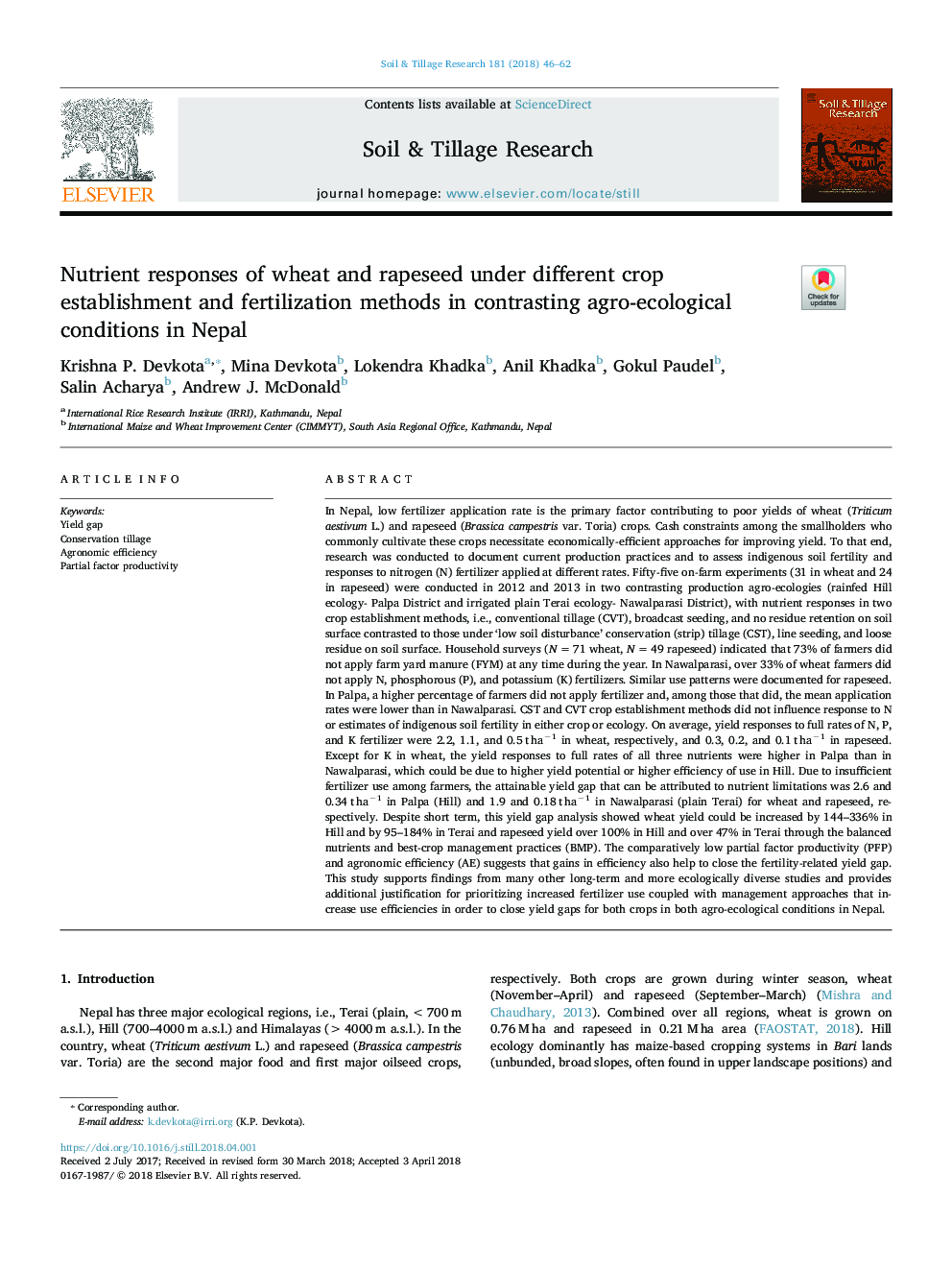| کد مقاله | کد نشریه | سال انتشار | مقاله انگلیسی | نسخه تمام متن |
|---|---|---|---|---|
| 6773010 | 1431822 | 2018 | 17 صفحه PDF | دانلود رایگان |
عنوان انگلیسی مقاله ISI
Nutrient responses of wheat and rapeseed under different crop establishment and fertilization methods in contrasting agro-ecological conditions in Nepal
ترجمه فارسی عنوان
پاسخ های تغذیه ای گندم و کلزا در زیر کشت های مختلف و روش های باروری در شرایط کنونی محیط زیست در نپال
دانلود مقاله + سفارش ترجمه
دانلود مقاله ISI انگلیسی
رایگان برای ایرانیان
کلمات کلیدی
شکاف تولید، خاک زراعی حفاظت، راندمان زراعی، بهره وری عامل،
موضوعات مرتبط
مهندسی و علوم پایه
مهندسی انرژی
انرژی های تجدید پذیر، توسعه پایدار و محیط زیست
چکیده انگلیسی
In Nepal, low fertilizer application rate is the primary factor contributing to poor yields of wheat (Triticum aestivum L.) and rapeseed (Brassica campestris var. Toria) crops. Cash constraints among the smallholders who commonly cultivate these crops necessitate economically-efficient approaches for improving yield. To that end, research was conducted to document current production practices and to assess indigenous soil fertility and responses to nitrogen (N) fertilizer applied at different rates. Fifty-five on-farm experiments (31 in wheat and 24 in rapeseed) were conducted in 2012 and 2013 in two contrasting production agro-ecologies (rainfed Hill ecology- Palpa District and irrigated plain Terai ecology- Nawalparasi District), with nutrient responses in two crop establishment methods, i.e., conventional tillage (CVT), broadcast seeding, and no residue retention on soil surface contrasted to those under 'low soil disturbance' conservation (strip) tillage (CST), line seeding, and loose residue on soil surface. Household surveys (Nâ¯=â¯71 wheat, Nâ¯=â¯49 rapeseed) indicated that 73% of farmers did not apply farm yard manure (FYM) at any time during the year. In Nawalparasi, over 33% of wheat farmers did not apply N, phosphorous (P), and potassium (K) fertilizers. Similar use patterns were documented for rapeseed. In Palpa, a higher percentage of farmers did not apply fertilizer and, among those that did, the mean application rates were lower than in Nawalparasi. CST and CVT crop establishment methods did not influence response to N or estimates of indigenous soil fertility in either crop or ecology. On average, yield responses to full rates of N, P, and K fertilizer were 2.2, 1.1, and 0.5â¯tâ¯haâ1 in wheat, respectively, and 0.3, 0.2, and 0.1â¯tâ¯haâ1 in rapeseed. Except for K in wheat, the yield responses to full rates of all three nutrients were higher in Palpa than in Nawalparasi, which could be due to higher yield potential or higher efficiency of use in Hill. Due to insufficient fertilizer use among farmers, the attainable yield gap that can be attributed to nutrient limitations was 2.6 and 0.34â¯tâ¯haâ1 in Palpa (Hill) and 1.9 and 0.18â¯tâ¯haâ1 in Nawalparasi (plain Terai) for wheat and rapeseed, respectively. Despite short term, this yield gap analysis showed wheat yield could be increased by 144-336% in Hill and by 95-184% in Terai and rapeseed yield over 100% in Hill and over 47% in Terai through the balanced nutrients and best-crop management practices (BMP). The comparatively low partial factor productivity (PFP) and agronomic efficiency (AE) suggests that gains in efficiency also help to close the fertility-related yield gap. This study supports findings from many other long-term and more ecologically diverse studies and provides additional justification for prioritizing increased fertilizer use coupled with management approaches that increase use efficiencies in order to close yield gaps for both crops in both agro-ecological conditions in Nepal.
ناشر
Database: Elsevier - ScienceDirect (ساینس دایرکت)
Journal: Soil and Tillage Research - Volume 181, September 2018, Pages 46-62
Journal: Soil and Tillage Research - Volume 181, September 2018, Pages 46-62
نویسندگان
Krishna P. Devkota, Mina Devkota, Lokendra Khadka, Anil Khadka, Gokul Paudel, Salin Acharya, Andrew J. McDonald,
